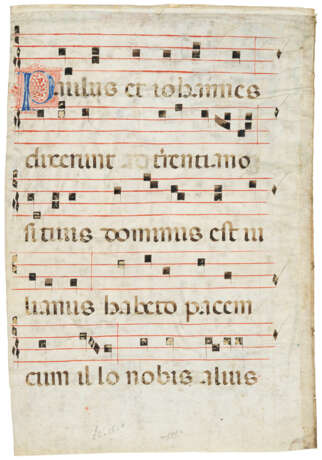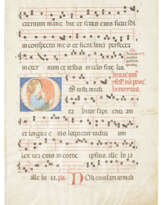ID 993383
Lot 7 | Tomasino da Vimercate (active 1390s-1417)
Valeur estimée
£ 3 000 – 5 000
Sts Paul and John before Julian the Apostate, historiated initial ‘P’ on a leaf from an illuminated manuscript Antiphonal on vellum [Lombardy, Milan, c.1395]
A sparkling and lively leaf depicting an unusual subject, from a known set of Antiphonals illuminated by one of the dominant artists of the Visconti court, Tomasino da Vimercate.
445 × 333mm, single leaf, five lines of text and music on four-line red staves, the text comprising the rarely-illuminated antiphon ‘Paulus et Iohannes dixerunt Iuliano […]’ for the feast of Sts Paul and John (26 June), the verso with the following antiphon ‘Paulus et Iohannes dixerunt ad Terencianum […]’, the initial depicting two saints at the left before an enthroned emperor with laurel wreath and staff, with attendants behind (overall cockling, some flaking and deliberate erasure of the text, slight cropping to upper margin). In an old giltwood frame.
Provenance:
(1) The present leaf was part of an Antiphonal or set of Antiphonals containing the Proper and Common of Saints as well as the Proper of Time, produced perhaps for a Camaldolese or Olivetan community at the end of the 14th century. For sister leaves see below and G. Freuler, Italian Miniatures, 2013, I, cat.43, pp.442-447.
(2) Unidentified English dealer, before 1971: the reverse with a price and price-code in pre-decimal currency ‘£2-15-0 m/a/-’
Sister leaves:
1. Simeon praying in the Temple, in an initial 'S' (G. Freuler, Italian miniatures, I, p.442)
2. St Peter visiting St Agatha in prison, in an initial 'Q', Christie's, 11 December 1969, lot 57.
3. St Peter freed from his prison, in an initial 'H', Austria, Zeileis collection.
4. The Miracle of Santa Maria della Neve, in an initial 'S', Christie's 4 June 2003, lot 7.
5. The Martyrdom of St Lawrence, in an initial 'L', Philadelphia, Free Library EM 27.22.
6. St Clement praying, in an initial 'O', Philadelphia, Free Library EM 27.23.
7. The Presentation of the Virgin, in an initial 'N', Milan, Biblioteca Trivulziana, pergamene sciolte C12.
8. Saint in a white habit praying to God, in an initial 'C', Italian private collection.
9. The Adoration of the Child, in an initial 'I', Washington, National Gallery of Art, B18-7, 161.
Illumination:
The saints of this initial are not the famous New Testament figures, but two martyrs who lived in the fourth century in the Roman Empire, and who died under Julian the Apostate (A.D. 361–63). It is the work of an artist first defined, and named, in relation to a Book of Hours in Modena. The certain recognition of one of the manuscripts attributed to him, a volume in Cambridge (Fitzwilliam Museum, CFM 9), as the book recorded in payments made by the Cathedral of Milan to the illuminator Tomasino da Vimercate, allowed him to be identified: K. Sutton, 'The Master of the Modena Hours, Tomasino da Vimercate and the Ambrosianae of the Cathedral of Milan', The Burlington Magazine, 133 (1991), pp.87-91.
Tomasino's lively compositions, decorative vocabulary and bright, blonde palette reveal an enduring debt to the previous generation of illuminators who worked for the Visconti court. These features make for a style of immediate appeal, and Tomasino dominated Milanese manuscript illumination from the 1390s until at least 1417. In addition to ecclesiastical patrons he too worked for members of the Visconti court and chancery and undertook the illustration of secular as well as religious manuscripts.
Special notice
No VAT is payable on the hammer price or the buyer's premium for this lot. Please see the VAT Symbols and Explanation section of the Conditions of Sale for further information
| Artiste: | Tomasino da Vimercate (XIVe siècle - XVe siècle) |
|---|---|
| Lieu d'origine: | Italie, Europe |
| Catégorie maison de vente aux enchères: | Manuscrits médiévaux et de la Renaissance |
| Artiste: | Tomasino da Vimercate (XIVe siècle - XVe siècle) |
|---|---|
| Lieu d'origine: | Italie, Europe |
| Catégorie maison de vente aux enchères: | Manuscrits médiévaux et de la Renaissance |
| Adresse de l'enchère |
CHRISTIE'S 8 King Street, St. James's SW1Y 6QT London Royaume-Uni | |
|---|---|---|
| Aperçu |
| |
| Téléphone | +44 (0)20 7839 9060 | |
| Commission | see on Website | |
| Conditions d'utilisation | Conditions d'utilisation |






